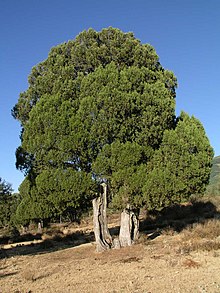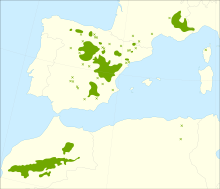Juniperus thurifera
| Juniperus thurifera | |
|---|---|

| |
| Juniperus thurifera at Prádena de la Sierra (Segovia, Spain) | |
| Scientific classification | |
| Kingdom: | Plantae |
| Clade: | Tracheophytes |
| Clade: | Gymnospermae |
| Division: | Pinophyta |
| Class: | Pinopsida |
| Order: | Cupressales |
| Family: | Cupressaceae |
| Genus: | Juniperus |
| Section: | Juniperus sect. Sabina |
| Species: | J. thurifera
|
| Binomial name | |
| Juniperus thurifera | |

| |
| Natural range | |
| Synonyms[2] | |
| |
Juniperus thurifera (Spanish juniper) is a species of juniper native to the mountains of the western Mediterranean region, from southern France (including Corsica) across eastern and central Spain to Morocco and locally in northern Algeria.[3][4]
The name thurifera comes from the Latin turifer, "producer/bearer of incense".[5]
It is a large shrub or tree reaching 6–20 metres (20–66 feet) tall, with a trunk up to 2 m (6+1⁄2 ft) in diameter and a broadly conical to rounded or irregular crown. The foliage is strongly aromatic with a spicy-resinous scent. The leaves are of two forms: juvenile needle-like leaves 8–10 millimetres (5⁄16–3⁄8 inch) long on seedlings and irregularly on adult plants, and adult-scale leaves 0.6–3 mm long on older plants; they are arranged in decussate opposite pairs. It is dioecious with separate male and female plants. The cones are berry-like, 7–12 mm in diameter, blue-black with a whitish waxy bloom, and contain 1–4 seeds; they are mature in about 18 months. The male cones are 3–4 mm long, and shed their pollen in early spring.[3][4][6][5]
There are two varieties, regarded as distinct by some authors,[3][6] but not by others:[4]
- Juniperus thurifera var. thurifera. Spain, France. Mature cones 8–12 mm, with 2–4 seeds.
- Juniperus thurifera var. africana Maire. Morocco, Algeria. Mature cones 7–8 mm, with 1–2 seeds.
Overall, the species is not considered threatened with healthy population in Spain;[1] however, the African population is threatened by severe overgrazing, mainly by goats, and is listed as Endangered.[3][6]
The largest Spanish Juniper forest in Europe is in the Sierra de Solorio.[7]

References[edit]
- ^ a b Farjon, A. (2013). "Juniperus thurifera". IUCN Red List of Threatened Species. 2013: e.T42255A2967372. doi:10.2305/IUCN.UK.2013-1.RLTS.T42255A2967372.en. Retrieved 13 November 2021.
- ^ The Plant List: A Working List of All Plant Species, retrieved 11 February 2017
- ^ a b c d Adams, R. P. (2004). Junipers of the World. Trafford. ISBN 1-4120-4250-X
- ^ a b c Farjon, A. (2005). Monograph of Cupressaceae and Sciadopitys. Royal Botanic Gardens, Kew. ISBN 1-84246-068-4
- ^ a b Earle, Christopher J., ed. (2018). "Juniperus thurifera". The Gymnosperm Database.
- ^ a b c Ecology and conservation of Juniperus thurifera Juniperus thurifera website
- ^ El Sabinar más extenso de Europa
Further reading[edit]
- Gastón González, A.; et al. (2016). "Juniperus thurifera in Europe: distribution, habitat, usage and threats" (PDF). European Atlas of Forest Tree Species. European Commission.

